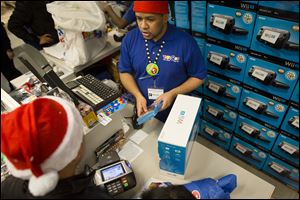
U.S. retail sales rose 0.3 percent in November
US retail sales rose 0.3 pct., reflecting start of holiday shopping and rebound from Sandy
12/13/2012
A customer makes a purchase in the Times Square Toys-R-Us store in New York. U.S. retail sales rose 0.3 percent in November from October, the Commerce Department said Thursday. That offset a 0.3 percent decline in October from September.
WASHINGTON — Americans spent more online in November to start the holiday season and began to replace cars and rebuild in the Northeast after Superstorm Sandy.
U.S. retail sales rose 0.3 percent in November from October, the Commerce Department said today. That offset a 0.3 percent decline in October from September.
The figures were much stronger after factoring lower gas prices. When excluding a large drop in gas station sales, retail sales increased a solid 0.8 percent.
The report offered a mixed signal for the holiday shopping season. Sales that reflect online shopping surged 3 percent — the biggest gain in 13 months. But department store sales tumbled and Americans spent less at stores like Wal-Mart and Target.
Some of the decline may be because of the storm. Still, economists worry that consumers may also be growing more cautious because of looming tax increases set to take effect in January.
Sandy made landfall on Oct. 29 and slowed business activity during the first couple of weeks of November — the start of the busiest shopping period of the year, Retailers can make up to 40 percent of their annual revenue in the final two months of the year.
The November retail sales report largely reflected a rebound from the storm. Auto sales jumped 1.5 percent, as many people sought to replace damaged vehicles. Sales at home improvement stores increased 1.6 percent.
Some figures suggest shoppers regained their enthusiasm for the holidays, perhaps later in the month. Electronic and appliance sales rose 2.5 percent. Furniture sales increased 1 percent.
Still, department stores sales dropped 0.8 percent. And sales at general merchandise stores, a broader category that includes Wal-Mart and Target, fell 0.9 percent.
In addition to the storm's impact, consumers might scale back on holiday shopping if they are concerned about the “fiscal cliff.” That's the name for tax hikes and spending cuts that are scheduled to go into effect next year if Congress and President Barack Obama cannot reach a deal to avert them.
The retail sales report is the government's first look at consumer spending. Consumer spending is important because it drives nearly 70 percent of economic activity.
The economy grew at a solid 2.7 percent annual rate in the July-September quarter. But the gains were mostly because businesses stepped up restocking, which drove more factory production.
Consumer spending actually slowed over the summer from the previous quarter. And many economists worry that consumers have remained cautious in the final three months of the year, because of the storm and their fears about higher taxes next year. That should keep growth below an annual rate of 2 percent in the October-December quarter, they say.